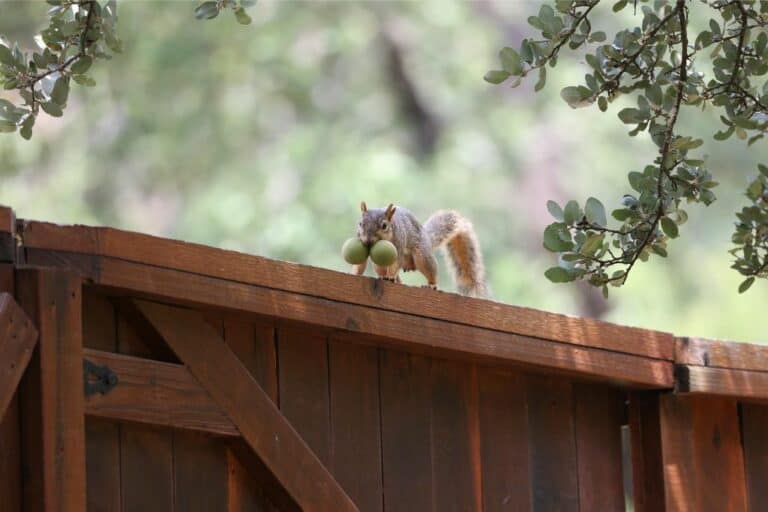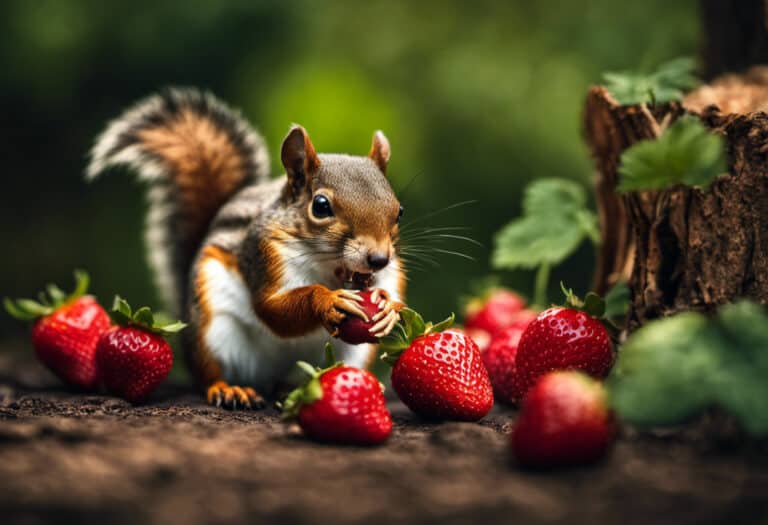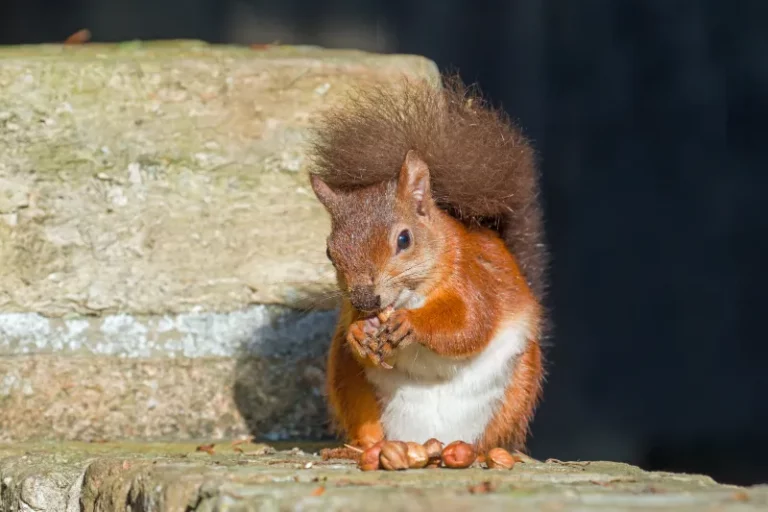How to Catch a Squirrel Without a Trap
Did you know that squirrels can be caught without the use of a trap? In fact, there are effective techniques that allow you to capture these nimble creatures using just your wits and a few simple tools.
Understanding squirrel behavior, identifying their favorite hangouts, and employing stealthy approaches are just a few of the strategies you’ll learn in this article.
So, if you’re ready to become a squirrel-catching expert, read on and discover how to catch a squirrel without a trap.
Key Takeaways
- Observing squirrel communication patterns can provide valuable insight into their behavior.
- Identifying the location of squirrel nests can help intercept them during travel.
- Identifying ideal squirrel locations increases the chances of finding and capturing them.
- Understanding mating habits and nesting preferences helps locate natural habitats.
Understanding Squirrel Behavior
Understanding squirrel behavior is essential in effectively catching a squirrel without using a trap. Squirrels are highly intelligent animals that rely on communication to navigate their surroundings. They use a combination of vocalizations, body language, and scent marking to communicate with other squirrels. By observing their communication patterns, you can gain valuable insight into their behavior and increase your chances of successfully catching one.
Additionally, understanding squirrel nesting behavior is crucial. Squirrels build nests, called dreys, using twigs, leaves, and other materials. These nests are typically located high up in trees and serve as a safe haven for the squirrels. By identifying the location of these nests, you can strategically position yourself to intercept the squirrel as it travels to and from its nest.
Identifying Ideal Squirrel Locations
When it comes to identifying ideal squirrel locations, there are a few key factors to consider.
First, you’ll want to look for optimal squirrel habitats, such as wooded areas with plenty of trees for shelter and nesting.
Additionally, observing and understanding their feeding patterns can provide valuable insights into their preferred locations.
Finally, utilizing natural attractants, such as food sources like nuts or fruits, can help draw squirrels to a specific area for observation or capture.
Optimal Squirrel Habitats
To catch a squirrel without a trap, you’ll want to look for trees with plenty of nuts and berries, as these are the optimal habitats for squirrels. Squirrels are highly adaptable creatures that can be found in various environments, but they are particularly drawn to areas abundant in food sources. Their mating habits and nesting preferences play a significant role in selecting their habitats. Squirrels mate twice a year, in the spring and fall, with the male often engaging in elaborate courtship displays to attract a mate. As for nesting, squirrels prefer to build their nests, called dreys, in the branches of trees. These dreys provide shelter and protection for their young. By understanding these aspects of squirrel behavior, you can strategically locate and observe their natural habitats.
| Squirrel Mating Habits | Squirrel Nesting Preferences |
|---|---|
| Mating occurs twice a year | Dreys are built in tree branches |
| Males engage in courtship displays | Provide shelter and protection for young |
| Spring and fall are mating seasons | Abundant in branches and foliage |
| Attracting a mate is important for reproduction | Nests are made of leaves, twigs, and moss |
| Mating habits influence habitat selection | Dreys are well hidden to avoid predators |
Identifying Feeding Patterns
If you want to identify feeding patterns, observe the areas where nuts and berries are consistently being consumed. Squirrels are opportunistic feeders, and their diet primarily consists of nuts, seeds, fruits, and berries.
By tracking movements and observing foraging behavior, you can gain insight into their preferred food sources and feeding habits. Look for signs such as chewed nut shells or discarded berry remnants.
Squirrels often create middens, which are collections of food items stored in a central location. These middens can provide valuable information about their feeding patterns and help you understand where they are most likely to gather and consume food.
Utilizing Natural Attractants
Utilizing natural attractants, such as nuts and berries, can effectively entice squirrels to gather in specific areas. Squirrels have a natural affinity for food, and by strategically placing these items, you can create a feeding station that will attract them.
Start by identifying areas where squirrels are commonly seen, such as near trees or in open spaces. Scatter a variety of nuts, such as walnuts or almonds, along with fresh berries, like strawberries or blueberries, in these locations. Squirrels have a keen sense of smell and will be drawn to the scent of these natural treats.
Make sure to replenish the food regularly to keep the squirrels coming back. By using food as bait, you can attract squirrels naturally and observe their behavior up close.
Gathering the Necessary Tools
When it comes to gathering the necessary tools for your task, it’s important to focus on three key points:
-
Essential tool selection: This involves choosing the right tools for the job based on their functionality and suitability. By selecting the essential tools, you can ensure that you have everything you need to complete the task efficiently.
-
DIY tool alternatives: Sometimes, you may not have access to specific tools. In such cases, DIY tool alternatives can be useful. These alternatives allow you to improvise with everyday household items, making it possible to complete the task even without the proper tools.
-
Proper tool handling: Safety should always be a priority when working with tools. Proper tool handling is crucial for both safety and efficiency. It involves using the tools correctly and taking necessary precautions to prevent accidents or injuries.
Essential Tool Selection
One essential tool for catching a squirrel without a trap is a sturdy net. Selecting the right net is crucial for a successful capture. Look for a net with a fine mesh that is strong enough to withstand the squirrel’s movements. It should also be lightweight and easy to maneuver.
Once you have chosen your net, it is important to properly maintain and store it. After each use, check the net for any damages or tears and repair them promptly. Clean the net thoroughly to remove any dirt or debris that may have accumulated.
Store the net in a dry and cool place to prevent any damage from moisture or extreme temperatures. Proper tool maintenance and storage will ensure your net remains in good condition and ready for use whenever you need to catch a squirrel.
DIY Tool Alternatives
If you’re looking for alternatives to traditional tools, you can try making a DIY squirrel-catching contraption at home. With a little bit of creativity and resourcefulness, you can create effective homemade squirrel traps.
Here are some ideas to get you started:
-
Bucket Trap: Attach a long stick to a bucket and place bait on the bottom. When the squirrel steps on the stick, it will tip the bucket and trap itself inside.
-
PVC Pipe Trap: Use a large PVC pipe and create a funnel at one end. Place bait inside the pipe and lean it against a tree. When the squirrel enters the pipe, it will slide down and get trapped.
-
Cardboard Box Trap: Cut a small hole in one side of a cardboard box and place bait inside. Prop the box up with a stick held by a string. When the squirrel enters the box, pull the string to close the trap.
Proper Tool Handling
To properly handle your tools, always remember to wear protective gloves and eyewear.
Proper tool maintenance and safety tips are crucial for ensuring the longevity of your tools and preventing accidents.
When it comes to tool maintenance, it is important to regularly clean and inspect your tools for any signs of wear or damage. This includes sharpening blades, oiling moving parts, and replacing any worn-out components.
Additionally, always store your tools in a dry and secure place to prevent rust and damage.
When using tools, be mindful of your surroundings and keep a firm grip to prevent slips. Never use tools for purposes they are not intended for, as this can lead to accidents.
Implementing Effective Feeding Techniques
Feeding squirrels regularly can help establish a routine and increase the chances of catching them without a trap. By implementing effective feeding techniques, you can attract squirrels to a specific location and gradually gain their trust. Here are some tips to ensure successful feeding:
-
Provide a variety of food options:
-
Offer a mix of nuts, seeds, and fruits to meet their nutritional requirements.
-
Experiment with different feeders, such as platform feeders or squirrel-proof feeders.
-
Place food in multiple locations to gauge their preferences.
-
Establish a feeding schedule:
-
Feed squirrels at the same time each day to create a routine.
-
Be consistent and patient, as it may take time for them to become comfortable with your presence.
-
Gradually reduce the distance:
-
Start by placing food a few feet away and gradually move closer over time.
-
Sit quietly nearby while they eat, allowing them to associate your presence with a positive experience.
Following these feeding techniques can increase the likelihood of catching squirrels without the need for a trap.
Mastering Stealthy Approaches
When trying to attract squirrels without using a trap, it’s important to master stealthy approaches. To successfully track squirrels, it is crucial to blend in with your surroundings and employ effective camouflage techniques.
Start by wearing clothing that matches the natural colors and patterns of the environment. This will help you to remain undetected as you move closer to your target. Additionally, be mindful of your movements and minimize any unnecessary noise. Squirrels have keen senses, so it’s essential to move slowly and cautiously.
Utilize natural cover such as trees, bushes, or rocks to hide your presence. By studying the behavior and habitat of squirrels, you can anticipate their movements and position yourself strategically.
Tackling Squirrel Deterrents
One effective way of keeping squirrels away is by using motion-activated deterrents. These devices use sensors to detect the presence of a squirrel and then emit a sound or spray a burst of water to scare them away. They are a non-harmful method of squirrel removal that can be easily installed in your garden or on your property.
Here are three sub-lists to help you understand more about squirrel deterrent techniques:
-
Ultrasonic devices: Emit high-frequency sounds that are unpleasant for squirrels, but inaudible to humans. These can be effective in deterring squirrels from your yard.
-
Water sprayers: These devices are connected to a water source and spray a jet of water when a squirrel triggers the motion sensor. Squirrels quickly learn to associate your property with getting wet, which keeps them away.
-
Predator decoys: Placing decoy animals, like owls or snakes, in your garden can help deter squirrels. The presence of potential predators makes squirrels feel unsafe and encourages them to find another location.
Employing Non-Lethal Capture Methods
To safely capture squirrels without using traps, you can employ non-lethal methods such as live squirrel traps or exclusion devices.
Understanding squirrel communication is key to effectively catching them. Squirrels use vocalizations, body language, and scent marking to communicate with each other. By observing their behavior and learning their patterns, you can increase your chances of success.
Developing patience and persistence is also crucial. Squirrels are agile and quick, so it may take time to outsmart them.
Set up your live trap in an area where squirrels frequent, such as near bird feeders or trees. Use bait that is appealing to squirrels, such as nuts or seeds.
Once captured, release the squirrel in a safe and suitable location away from your property. Remember, always handle squirrels with care to avoid injuries to both you and the animal.
Frequently Asked Questions
Can I Catch a Squirrel Without Using Any Tools or Equipment?
You can catch a squirrel without using any tools or equipment. To attract squirrels, use natural squirrel deterrents like bird feeders and nut trees. Observing their behavior and setting up strategic feeding spots can help you catch one.
How Long Does It Usually Take to Catch a Squirrel Using the Non-Lethal Capture Methods?
To catch a squirrel without a trap, you’ll need patience and persistence. It can take anywhere from a few hours to several days to successfully capture a squirrel using non-lethal methods.
Are There Any Specific Types of Food That Are More Effective in Luring Squirrels?
To lure squirrels effectively, use baits such as nuts, seeds, and fruits. These appetizing treats mimic their natural diet, attracting them like a magnet. Follow these tips for non-lethal capture and increase your chances of success.
What Should I Do if I Accidentally Catch a Squirrel That I Didn’t Intend to Catch?
If you accidentally catch a squirrel, it’s important to prevent bites and release it safely. Approach slowly and calmly, wearing gloves for protection. Gently hold the squirrel’s body and release it in a safe, open area away from people.
Is It Possible to Catch a Squirrel Without Them Noticing or Becoming Suspicious?
To catch a squirrel without them noticing or becoming suspicious, approach slowly and quietly. Use a distraction, like food or a noise, to divert their attention. Be patient and wait for the right moment to catch them.
Conclusion
In conclusion, catching a squirrel without a trap requires a combination of understanding their behavior, identifying their ideal locations, and implementing effective feeding techniques.
By mastering stealthy approaches and tackling squirrel deterrents, you can increase your chances of a successful capture.
Remember, it’s important to employ non-lethal capture methods to ensure the safety and well-being of these fascinating creatures.
Just like a squirrel nimbly navigates through the trees, with patience and persistence, you too can master the art of squirrel catching.
So go ahead, put your skills to the test and embark on this exciting adventure!






